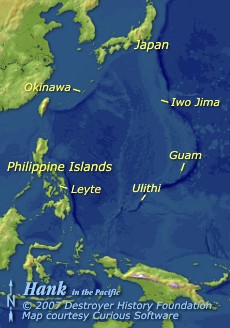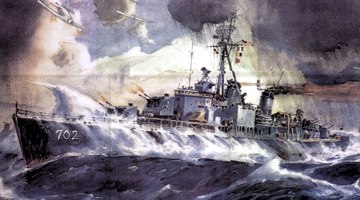

After conducting trials on Long Island Sound during the great hurricane of September 1944 and completing shakedown off Bermuda through 18 October, Hank returned to New York; then sortied with a task force that included Missouri (BB 63), Texas (BB 35) and Arkansas (BB 33) for the Panama Canal, continuing on to Pearl Harbor via San Francisco.
Attached to Destroyer Squadron 62, she joined Task Force 38 with DesDiv 124 sisters Weeks, Wallace L. Lind (DD 703) and Borie (DD 704), all from Federal. Operating initially from Ulithi, the “Hanko Maru” participated in strikes against the Japanese home islands in February and March before heading for Okinawa. Engaging in shore bombardment there, she took up station on a radar picket station where, on 11 April, a suicide plane attacked. Deflected by Hank’s anti-aircraft fire, the plane killed three men before crashing and exploding close aboard.

Hank’s Last Battle by Arthur Beaumont.
After retiring to Ulithi for repairs, Hank returned to Okinawa 1 May for screening and radar pickup duty. On 18 July, her squadron and Cruiser Division 18 closed the Honshu coast for an anti-shipping sweep outside Tokyo Bay.
On 9 August, Hank and Borie were operating with Task Force 38, which was conducting air strikes on Honshu and Hokkaido. At 1459, A “Val” crashed Borie, killing 34 with thirteen missing and 66 wounded. The next day, Hank picked up three of the missing. News of the war’s end reached them as they set course for Norfolk.
Hank entered Tokyo Bay 10 September to participate in the occupation of Japan. Remaining in the theater until 30 December, she returned to Charleston via Eniwetok, Pearl Harbor, San Diego and the Panama Canal, having earned four service stars on her Asiatic-Pacific Campaign Ribbon.
Like her 2,200-ton sisters, Hank was not decommissioned after World War II, but remained in continuous US Navy service, operating from New Orleans for reserve training cruises and good will visits to Caribbean and Central American. Transferred to the Sixth Fleet in the Mediterranean Sea for five months in late 1949, she returned to Norfolk in January 1950 and sailed for the Far East in September.
During the Korean War, the “Happy Henry” earned four more battle stars, participating in the blockade and evacuation of Wonsan Harbor and evacuation of Hungnam in 1950 and the recapture and consolidation of Seoul and Inchon in 1951. Returning to Norfolk for overhaul in June, she resumed peacetime training operations, Caribbean exercises, and annual deployments to the Mediterranean, where she was present during the 1956 Suez Canal crisis.
In May 1962, Hank was one of the recovery ships during astronaut Scott Carpenter’s Mercury flight. In October, she operated with Independence on blockade and surveillance duty during the Cuban Missile Crisis. Designated a Naval Reserve Training Ship in October 1963, she operated from Philadelphia along the East Coast.
Decommissioned 1 July 1972, she and Borie were sold to Argentina where they entered service as ARA Comodoro Seguí (D-25) and ARA Hipólito Bouchard (D-26). She served in the Falkland Islands War in 1982 before being sold for scrap in 1983.
Beginning in 1989, Hank veterans began holding annual reunions; the USS Hank Association remains active today.
Source: USS Hank Reunion Organization scrapbook of Dick and Margo Dinneen; DANFS.